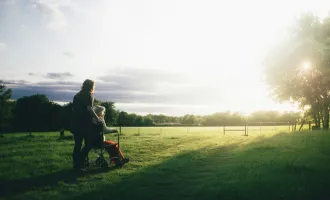Biking the Bridge to the Headlands
As with many local tourist attractions, making the pilgrimage across one of the greatest bridges of America’s golden age is something that most residents of our fair city never get around to.
So, put Dolores Park on the back burner this weekend, and make the trek. It is a journey through fog and time that delivers you in glorious fashion to the near-wilderness of the Marin Headlands. The bridge and the headlands individually would warrant a weekend jaunt, and together they make an urban outing beyond compare.
In a display of renewed confidence as the nation came out of the Great Depression, the Golden Gate Bridge opened in 1937. At a price of $35 million, the project was completed under budget and ahead of schedule — something unimaginable today. Its Art Deco style celebrates the ascendancy of industrialism in the interwar period. A proud span indeed.
At the time of its construction, the Golden Gate was the tallest and longest suspension bridge in the world. Although it has historically been associated with the private automobile, in recent years, bicycles have become the most romantic mode of transport for making the crossing.
There are a number of bike routes that will deliver you safely to the southern terminus of the bridge. I recommend two for their beauty and navigational simplicity.
Either route assumes starting from the Richmond District (the bike routes north-south across Golden Gate Park are surprisingly complex and would require an article of their own to be given proper treatment).
From the Richmond, the first route to the bridge heads north on 25th Avenue. This turns into Lincoln Boulevard as it skirts Baker Beach. Rising up bluffs drenched in sun, fog and sea spray, with the horrible noises of cars rushing past, it delivers you to the majestic span.
The second route is more inland, shaded and quieter. Take Arguello Boulevard north until it enters the Presidio with a single block of precipitous grade (many bikers will dismount and walk here) before flattening out in the eucalyptus and cypress forest above.
You’ll pass a mysterious 90-plus foot conical tower made of logs, which, it turns out, is a sculpture called Spire, by the famous nature-meets-civilization artist Andy Goldsworthy, installed in 2008.
Promptly thereafter, turn left onto Washington Boulevard, which meanders past stately apartments of a bygone war-machine and a few delectable views towards Land’s End. A final right turn onto Lincoln Boulevard (watch out for cars!) will lead promptly to the bridge.
The bridge itself, while fantastic in many ways, is not exactly pleasant as far as the actual biking goes. Often bikes are routed onto the west side path, but sometimes that side is closed and bikes must share the east side path with the gawking gaggles of pedestrians.
Either way, traffic can be tight, especially at the two grand columns, around which the paths are forced to skirt at awkward 90-degree angles. Proceed slowly, and take advantage of the halting pace to enjoy the views framed by cables of International Orange, the hue of the structure chosen for its visibility and aesthetics.
Once across, you will have entered a road-biker’s paradise, the Marin Headlands to the west. Take your first possible left turn after the crossing on Alexander Avenue, which turns into Conzelman Road once it is west of the highway. The headlands, fortunately, are undeveloped, save for the incredible rolling road hovering above the sea and the odd abandoned World War II-era gun bunker.
A clockwise loop (on Conzelman Road to Field Road to Bunker Road to McCullough Road) will take you past Rodeo Lagoon and the Headlands Center for the Arts and back again to the hilltop.
The day I went, this road was closed to automobile traffic due to the federal government shutdown, which made it especially lovely.
If you’re lucky, the government will shut down again soon, and cars will once again be blissfully banned from our beautiful national parklands. Such a day would be the perfect time to bike across the Golden Gate Bridge, contrasting the ineptitude of the present-day government with the proud statement of a past government’s architectural masterpiece.


